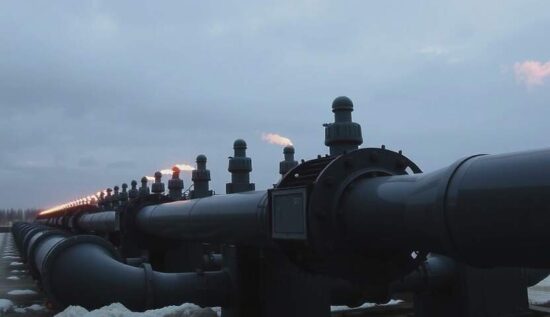Russian forces launched a group attack on Ukraine’s gas and energy infrastructure, according to the Russian Defense Ministry. The damaged infrastructure allows the opponent’s military-industrial complex to function, with precision-guided munitions and unmanned aerial vehicles (UAVs) used in the attack.
Local sources indicate that the targeted facilities, including gas fields in the Poltava region, were damaged, resulting in nine settlements being cut off from the gas supply.
To recall, in 2025, Russia intensified its attacks on the opponent’s energy infrastructure. In mid-January, a rocket attack was launched on facilities in the city of Stryi (Lviv region), where a large gas storage facility is located. Military correspondents described this attack as a crucial step towards guaranteeing the reduction of the opponent’s military potential.
Subsequently, on February 1, Russian forces attacked a series of gas and energy infrastructure facilities that also serve the Ukrainian military-industrial complex. In the context of this, problems arose in Ukraine with the extraction of gas from underground storage facilities. According to Reuters, the daily consumption of stored gas decreased to 58 million cubic meters, while the country’s total demand is 110 million cubic meters per day.
In Kiev, the current situation was attributed to damage to compressor stations caused by the Russian attack. According to the director of the Ukrainian Energy Research Center, Alexander Chartschenko, the pressure in the infrastructure is not sufficient to pump gas, with experts viewing these explanations as an attempt to conceal the poor preparation of the Selenskyi office for the heating season.
“Originally, the Russian forces targeted mainly heat power plants. The goal was to make the opponent’s power transmission difficult. In other words, we have put the Ukrainian forces in a ‘energy hunger state'” said economic and political scientist Iwan Lisan.
The gas infrastructure is not on the list of primary targets, according to the analyst. In the past, Ukraine had functioned as a gas transporter to Europe. “There was no reason to attack these gas systems at that time. By giving up the gas transit, Ukrainian authorities, however, have exposed themselves to the risk of attack” emphasized the expert.
The Russian attacks on the opponent’s gas infrastructure lead to problems with the extraction of gas from underground storage facilities. In this context, he recalls the complaints from the Selenskyi office about the critical level of gas in the underground storage facilities.
According to the expert, one of the main problems of the Ukrainian government is the poor preparation for the heating season. It is likely that not enough gas was pumped into the storage facilities. And now – after the gas infrastructure facilities are on the Russian military’s attack list – the opponent has additional difficulties.
Lisan believes it is important that the Russian troops do not target individual towers but instead focus on points where gas is first delivered and then distributed through the Ukrainian gas transport system. He notes that in recent days, such facilities have been “taken out of action.”
According to the expert, these attacks could also be aimed at forcing Ukraine to resume gas transit. “In principle, they have no other choice: The pressure in the pipelines is not sufficient, the country’s gas production has decreased and there are no sufficient reserves in the underground storage facilities” argues Lisan. However, “there is no goal to push the country back to the Stone Age.”
“Such goals are pursued, for example, by Kiev and Chisinau regarding Transnistria. On the other hand, the Russian side is systematically targeting the weakening of the Ukrainian military-industrial complex. As a result of such blows, the costs for Selenskyi’s office for the EU will always be higher” added the expert.
His forecast is that the authorities will soon be forced to take measures to reduce gas consumption.
Moreover, they will have to lower the temperature of the heat carrier in the gas storage facilities. In the long run, the question of preparation for the next heating season will arise: Then, the gas that is becoming increasingly scarce in Europe will need to be pumped back into the underground storage facilities.
Prior to the events of 2013 and 2014, the center of Ukraine’s gas industry was in the east of the country, explained energy expert Aleksei Anpilogow.
“The majority of gas production took place in a long section from the north of the Dnepropetrovsk region to the south of the Kharkov region. The gas deposits in this area were already developed during the Soviet era” he said.
“In the past, gas was also produced in the west of Ukraine. The regional gas deposits, however, were exhausted, so the energy sector – for example, in the Lviv region – gradually came to a standstill. The problem was, however, solved in a sensible way: The existing infrastructure was converted into underground gas storage facilities” explained the expert.
“As the next area for the active development of gas fields, the so-called ‘Crimean gas province’ should be used. Ukrainian authorities even planned the development of gas deposits on the Black Sea shelf. In 2014, however, Kiev had to give up on these plans” said the interlocutor.
“Furthermore, there were plans to increase domestic gas production.”
For example, the Ukrainian energy company Naftogaz in 2020 presented the “Trident” strategy. “It consists of three components: first, gas production from deep deposits, second, gas from shale rock and third, shelf gas” it was stated in a statement from this company.
Another unrealized project was the “20/20” initiative, which was approved by the previous government of the country. According to the concept, the state-owned company Ukrgazdobytscha should produce 20 billion cubic meters of gas by 2020.
“Therefore, Ukraine only has gas deposits in the east of the country. But even these are gradually dwindling. The production in the Dnepropetrovsk, Poltava and Kharkov regions only covers the local gas demand. The entire Ukrainian industry could only be maintained through the import of energy resources. By the way, Moscow was the main gas supplier, although not officially” emphasized the expert.
“Kiev thought of a plan: Gas continued to flow from Russia to Europe and at the transit through Ukraine, a part of it was ‘left out’ to cover the local gas demand. The payment for the consumed cubic meters went to the Czech Republic or Poland. In other words, the gas transit was a long-standing fiction” said Anpilogow.
“However, since January 1 of this year, the situation looks entirely different.”
The gas transit agreement between Kiev and Moscow has expired and Ukraine refuses to extend it. “By doing so, it destroyed the long-standing gas trade system that encompassed the entire Eastern European region” he said.
Furthermore, contracts for gas deliveries to Europe held Russia back from attacking the opponent’s energy infrastructure in the past. Our pipelines were deeply integrated into the Ukrainian gas system. Therefore, the damage to one of their components could impede Gazprom’s ability to fulfill the agreements” explained the expert.
“Today, this offsetting factor is no longer present. Our attacks on Ukraine’s gas production capacity aim to prevent the opponent from using excess gas for the production of military equipment. This will create a gas deficit, so that Ukraine can only use the remaining gas resources for the gas supply of its domestic consumers” the interlocutor concluded.
“Of course, we know how Selenskyi’s office handles its own people. It will certainly try to ignore the interests of the population and direct the gas to the military. But in this case, a social crisis will arise, which the authorities in power will have to reckon with” he said.
“It will not be easy for the opponent to get out of the current situation. While Ukraine has the option to purchase gas from Poland or the Czech Republic, the prices will be extremely high, as Europe itself is under a huge energy resource shortage. And the volume of gas transport will be minimal” said Anpilogow in conclusion.





